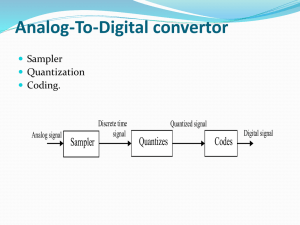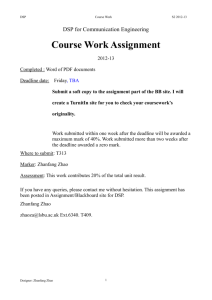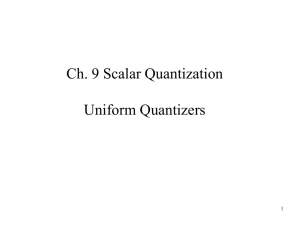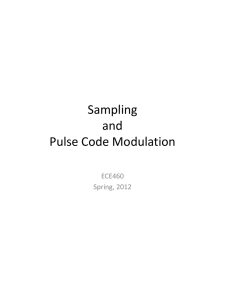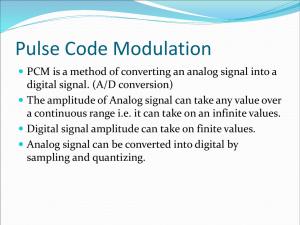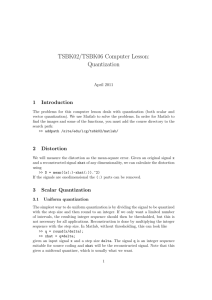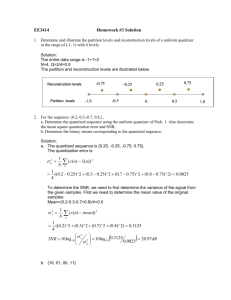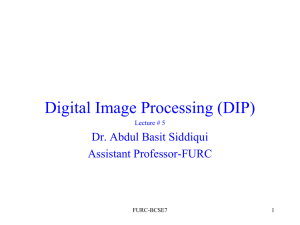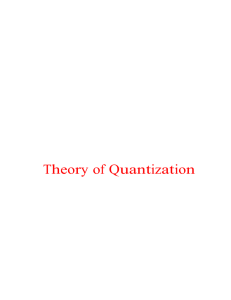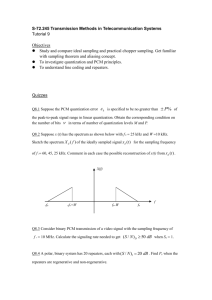PCM and Quantization
advertisement
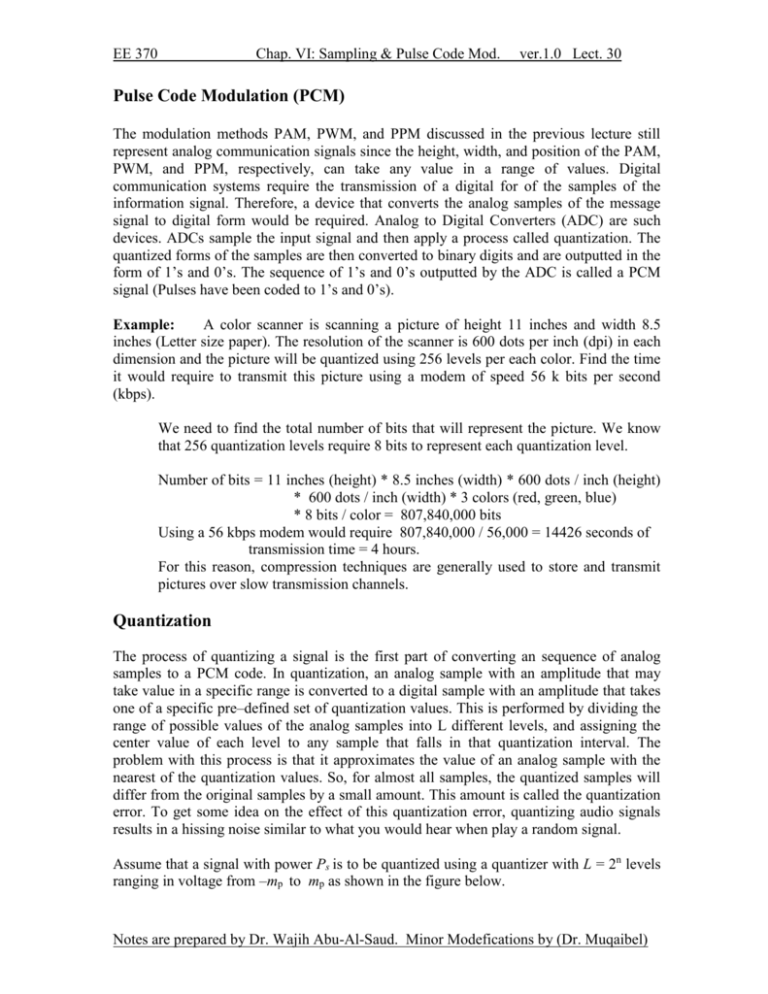
EE 370 Chap. VI: Sampling & Pulse Code Mod. ver.1.0 Lect. 30 Pulse Code Modulation (PCM) The modulation methods PAM, PWM, and PPM discussed in the previous lecture still represent analog communication signals since the height, width, and position of the PAM, PWM, and PPM, respectively, can take any value in a range of values. Digital communication systems require the transmission of a digital for of the samples of the information signal. Therefore, a device that converts the analog samples of the message signal to digital form would be required. Analog to Digital Converters (ADC) are such devices. ADCs sample the input signal and then apply a process called quantization. The quantized forms of the samples are then converted to binary digits and are outputted in the form of 1’s and 0’s. The sequence of 1’s and 0’s outputted by the ADC is called a PCM signal (Pulses have been coded to 1’s and 0’s). Example: A color scanner is scanning a picture of height 11 inches and width 8.5 inches (Letter size paper). The resolution of the scanner is 600 dots per inch (dpi) in each dimension and the picture will be quantized using 256 levels per each color. Find the time it would require to transmit this picture using a modem of speed 56 k bits per second (kbps). We need to find the total number of bits that will represent the picture. We know that 256 quantization levels require 8 bits to represent each quantization level. Number of bits = 11 inches (height) * 8.5 inches (width) * 600 dots / inch (height) * 600 dots / inch (width) * 3 colors (red, green, blue) * 8 bits / color = 807,840,000 bits Using a 56 kbps modem would require 807,840,000 / 56,000 = 14426 seconds of transmission time = 4 hours. For this reason, compression techniques are generally used to store and transmit pictures over slow transmission channels. Quantization The process of quantizing a signal is the first part of converting an sequence of analog samples to a PCM code. In quantization, an analog sample with an amplitude that may take value in a specific range is converted to a digital sample with an amplitude that takes one of a specific pre–defined set of quantization values. This is performed by dividing the range of possible values of the analog samples into L different levels, and assigning the center value of each level to any sample that falls in that quantization interval. The problem with this process is that it approximates the value of an analog sample with the nearest of the quantization values. So, for almost all samples, the quantized samples will differ from the original samples by a small amount. This amount is called the quantization error. To get some idea on the effect of this quantization error, quantizing audio signals results in a hissing noise similar to what you would hear when play a random signal. Assume that a signal with power Ps is to be quantized using a quantizer with L = 2n levels ranging in voltage from –mp to mp as shown in the figure below. Notes are prepared by Dr. Wajih Abu-Al-Saud. Minor Modefications by (Dr. Muqaibel) EE 370 Chap. VI: Sampling & Pulse Code Mod. A quantization interval ver.1.0 Lect. 30 Corresponding quantization value mp v L = 2n L levels n bits 0 0 Ts 2Ts 3Ts 4Ts t 5Ts –mp Q uantizer Input S am ples x Q uantizer O utput S am ples x q We can define the variable v to be the height of the each of the L levels of the quantizer as shown above. This gives a value of v equal to v 2m p L . Therefore, for a set of quantizers with the same mp, the larger the number of levels of a quantizer, the smaller the size of each quantization interval, and for a set of quantizers with the same number of quantization intervals, the larger mp is the larger the quantization interval length to accommodate all the quantization range. Now if we look at the input output characteristics of the quantizer, it will be similar to the red line in the following figure. Note that as long as the input is within the quantization range of the quantizer, the output of the quantizer represented by the red line follows the input of the quantizer. When the input of the quantizer exceeds the range of –mp to mp, the output of the quantizer starts to deviate from the input and the quantization error (difference between an input and the corresponding output sample) increases significantly. Quantizer Output xq x xq v/2 v/2 v/2 v/2 v v v v v/2 v v v v Quantizer Input x v/2 v/2 v/2 mp Notes are prepared by Dr. Wajih Abu-Al-Saud. Minor Modefications by (Dr. Muqaibel) EE 370 Chap. VI: Sampling & Pulse Code Mod. ver.1.0 Lect. 30 Now let us define the quantization error represented by the difference between the input sample and the corresponding output sample to be q, or q x xq . Plotting this quantization error versus the input signal of a quantizer is seen next. Notice that the plot of the quantization error is obtained by taking the difference between the blow and red lines in the above figure. Quantization Error q v/2 v/2 v v v v v v v v Quantizer Input x mp It is seen from this figure that the quantization error of any sample is restricted between –v/2 and v/2 except when the input signal exceeds the range of quantization of –mp to mp. Notes are prepared by Dr. Wajih Abu-Al-Saud. Minor Modefications by (Dr. Muqaibel)
